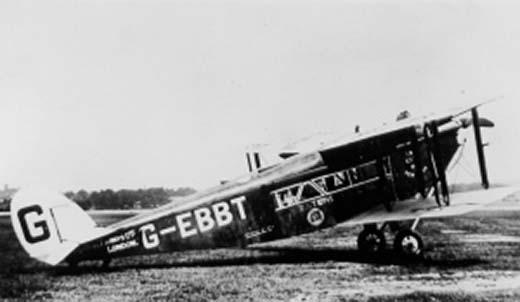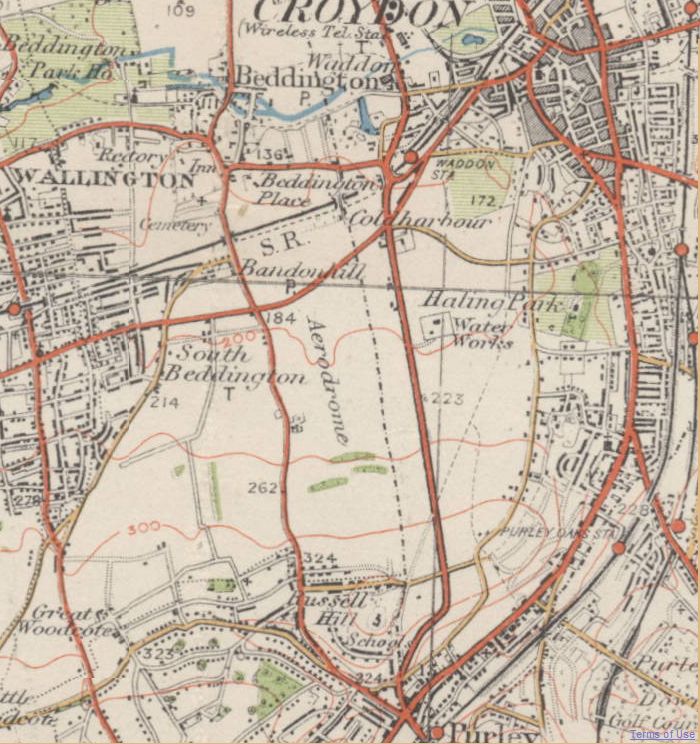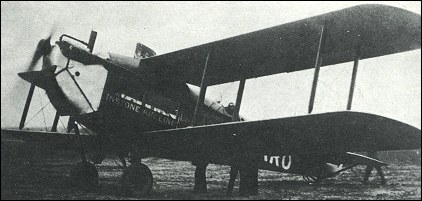|
DH.34
The de Havilland DH.34 was a single engined British biplane airliner built by the de Havilland Aircraft Company in the 1920s. 12 were built, with the DH.34 serving with Imperial Airways and its predecessors for several years. Design and development By 1921, enough experience had been gained with operation of the de Havilland DH.18 to realise that aircraft needed to be more efficient to improve the economics of air travel. de Havilland therefore built the ten-passenger DH.29 monoplane, while starting work on the design of the DH.32, a biplane of similar size and capacity to the eight-passenger DH.18, but with a less powerful but more economical Rolls-Royce Eagle engine. Owing to the urgent need for more capacity, however, work on the DH.29 and DH.32 was stopped and the DH.34 biplane was designed, with a similar fuselage to the DH.29, accommodating ten passengers. The DH.34 had a wooden, plywood-clad fuselage, with the cockpit (for two pilots) being positioned ahead of the wings ... [...More Info...] [...Related Items...] OR: [Wikipedia] [Google] [Baidu] |
Daimler Airway
Daimler Airway was an airline subsidiary of the Birmingham Small Arms Company (BSA)'s Daimler Company. It was created to use some of the assets of the failed ventures Airco and its subsidiary, Aircraft Transport and Travel, which was acquired by BSA in February 1920. History Daimler Company established Daimler Air Hire as a private air hire company on 7 June 1919. Daimler Hire's managing director was Lieutenant Colonel Frank Searle CB, DSO, who had also been a senior manager of Daimler prior to his war service. During the First World War Daimler had acquired considerable aviation experience manufacturing aero engines and aircraft, including bombers. They built Gnome Monosoupape and Le Rhone engines under Airco's licence. The last wartime aircraft Daimler produced was the Airco DH.10 Amiens bomber when they were building 80 aeroplanes a month. Their own test-ground beside the Daimler factory had been compulsorily purchased to become the main RAF testing ground for aircraft ... [...More Info...] [...Related Items...] OR: [Wikipedia] [Google] [Baidu] |
Imperial Airways
Imperial Airways was the early British commercial long-range airline, operating from 1924 to 1939 and principally serving the British Empire routes to South Africa, India, Australia and the Far East, including Malaya and Hong Kong. Passengers were typically businessmen or colonial administrators, and most flights carried about 20 passengers or less. Accidents were frequent: in the first six years, 32 people died in seven incidents. Imperial Airways never achieved the levels of technological innovation of its competitors and was merged into the British Overseas Airways Corporation (BOAC) in 1939. BOAC in turn merged with the British European Airways (BEA) in 1974 to form British Airways. Background The establishment of Imperial Airways occurred in the context of facilitating overseas settlement by making travel to and from the colonies quicker, and that flight would also speed up colonial government and trade that was until then dependent upon ships. The launch of the airline ... [...More Info...] [...Related Items...] OR: [Wikipedia] [Google] [Baidu] |
Croydon Airport
Croydon Airport (former ICAO code: EGCR) was the UK's only international airport during the interwar period. Located in Croydon, South London, England, it opened in 1920, built in a Neoclassical style, and was developed as Britain's main airport, handling more cargo, mail, and passengers than any other UK airport at the time. Innovations at the site included the world's first air traffic control and the first airport terminal. During World War II the airport was named RAF Croydon as its role changed to that of a fighter airfield during the Battle of Britain; and in 1943 RAF Transport Command was founded at the site, which used the airport to transport thousands of troops into and out of Europe. After the Second World War, its role returned to civil aviation, but the role of London's primary international airport passed to London Heathrow Airport. Croydon Airport closed in 1959. It had been known under eight different names while it was active. In 1978, the terminal buildin ... [...More Info...] [...Related Items...] OR: [Wikipedia] [Google] [Baidu] |
Airliner
An airliner is a type of aircraft for transporting passengers and air cargo. Such aircraft are most often operated by airlines. Although the definition of an airliner can vary from country to country, an airliner is typically defined as an airplane intended for carrying multiple passengers or cargo in commercial service. The largest of them are wide-body jets which are also called twin-aisle because they generally have two separate aisles running from the front to the back of the passenger cabin. These are usually used for long-haul flights between airline hubs and major cities. A smaller, more common class of airliners is the narrow-body or single-aisle. These are generally used for short to medium-distance flights with fewer passengers than their wide-body counterparts. Regional airliners typically seat fewer than 100 passengers and may be powered by turbofans or turboprops. These airliners are the non- mainline counterparts to the larger aircraft operated by the major car ... [...More Info...] [...Related Items...] OR: [Wikipedia] [Google] [Baidu] |
De Havilland
The de Havilland Aircraft Company Limited () was a British aviation manufacturer established in late 1920 by Geoffrey de Havilland at Stag Lane Aerodrome Edgware on the outskirts of north London. Operations were later moved to Hatfield in Hertfordshire. Known for its innovation, de Havilland was responsible for a number of important aircraft, including the Moth biplane which revolutionised aviation in the 1920s; the 1930s Fox Moth, a commercial light passenger aircraft; the wooden World War II Mosquito multirole aircraft; and the pioneering passenger jet airliner Comet. The de Havilland company became a member of the Hawker Siddeley group in 1960, but lost its separate identity in 1963. Later, Hawker Siddeley merged into what is eventually known today as BAE Systems, the British aerospace and defence business. The de Havilland name lives on in De Havilland Canada, which owns the rights to the name and the aircraft produced by de Havilland's former Canadian subsidiary, inc ... [...More Info...] [...Related Items...] OR: [Wikipedia] [Google] [Baidu] |
Instone Air Line
Instone Air Line was an early British airline from 1919 to 1924. Along with other private airlines of the time, it was absorbed into Imperial Airways. This airline is not to be confused with Instone Air Line (1981) of Stansted, which operated from 1981 to about 1996 with Bristol Freighter and Douglas DC-6. History S. Instone & Company Limited, a shipping company set up by Sir Samuel Instone, had operated a private air service from Cardiff via London's Hounslow Heath Aerodrome to Le Bourget aerodrome, near Paris, since 1919. From April 1920 it ran the service between London and Paris as a public service using the name Instone Air Line. In 1920 it was the first airline to transport a racehorse and on 1 January 1922 the company introduced uniforms to its pilots and staff; possibly the first airline to do so. It started a London to Cologne ( Butzweilerhof) service in May 1922. It stopped operating the London-Paris route in October 1922 due to competition. In 1923, a Government ... [...More Info...] [...Related Items...] OR: [Wikipedia] [Google] [Baidu] |
Marden Airfield
Marden Airfield was an airfield in Marden, Kent, United Kingdom. It was operation from 1917 to 1935. Initially a Royal Flying Corps airfield during the First World War it was used post-war as an Emergency Landing Strip, RAF Marden by the Royal Air Force. It was also known as Pagehurst Emergency Landing Ground. Later serving as a civil Emergency Landing Ground, the airfield closed in 1935. The site housed a Royal Air Force transmitter station during the Second World War. Location Marden Airfield was located east of Marden and west of Staplehurst, and south of the Ashford - Tonbridge railway line, in Ordnance Survey grid squarTQ7643 (), thus north east of Marden Thorn. Although known as Marden Airfield, most of the site lies within the parish of Staplehurst. The site is above sea level and was .''Marden's Aviation History'', p9 History Marden Airfield was established in January 1917. It was a Second Class Landing Ground. Facilities were limited to a Bessonneau hangar located i ... [...More Info...] [...Related Items...] OR: [Wikipedia] [Google] [Baidu] |
Alexandra Park Aerodrome (Manchester)
Alexandra Park Aerodrome was the second purpose-built aerodrome in the Manchester area in England. The site was chosen by the War Department in 1917 because of its open agricultural nature, and lay between the neighbouring districts of Fallowfield, Chorlton-cum-Hardy, Whalley Range, Greater Manchester, Whalley Range, Withington and West Didsbury, at the junction of A5103, Princess Road and Mauldeth Road West, three miles south of Manchester's city centre: the land was owned by the Egerton Estate. The aerodrome's brief existence is commemorated on a plaque in the sports pavilion at Hough End Playing Fields, which now occupy part of the site. A commemorative plaque was unveiled on 7 July 2007 to mark the 90th anniversary of the aerodrome and is located in the grounds of No. 184 (Manchester South) Squadron, Air Training Corps, Air Cadets, in Hough End Crescent. Operational history 1918–19 Following the closure of the Trafford Park Aerodrome (Manchester) in 1918 after only se ... [...More Info...] [...Related Items...] OR: [Wikipedia] [Google] [Baidu] |
De Havilland Doncaster
The de Havilland DH.29 Doncaster was a British long-range high-wing monoplane of the 1920s built by de Havilland. History The DH.29 Doncaster was ordered by the British Air Ministry as an experimental long-range monoplane. The aircraft was a high-wing cantilever monoplane with unswept wings of wooden structure with a fabric covering. It had a box section wooden fuselage with a single fin. The crew of two sat in an open cockpit ahead of the wing. Two aircraft were built between 1920 and 1921 at Stag Lane Aerodrome. Early testing of the first aircraft ( Serial ''J6849'') resulted in a redesign of the engine installation. The second aircraft (Registered G-EAYO) was built as a ten-seat commercial aircraft. The airlines were not interested and further development was abandoned, effort being put into the biplane de Havilland DH.34. A proposed military reconnaissance version, the DH.30, was never built. The two aircraft finished their life at RAF Martlesham Heath with tests and tr ... [...More Info...] [...Related Items...] OR: [Wikipedia] [Google] [Baidu] |
WikiProject Aircraft
A WikiProject, or Wikiproject, is a Wikimedia movement affinity group for contributors with shared goals. WikiProjects are prevalent within the largest wiki, Wikipedia, and exist to varying degrees within sister projects such as Wiktionary, Wikiquote, Wikidata, and Wikisource. They also exist in different languages, and translation of articles is a form of their collaboration. During the COVID-19 pandemic, CBS News noted the role of Wikipedia's WikiProject Medicine in maintaining the accuracy of articles related to the disease. Another WikiProject that has drawn attention is WikiProject Women Scientists, which was profiled by '' Smithsonian'' for its efforts to improve coverage of women scientists which the profile noted had "helped increase the number of female scientists on Wikipedia from around 1,600 to over 5,000". On Wikipedia Some Wikipedia WikiProjects are substantial enough to engage in cooperative activities with outside organizations relevant to the field at issue. For e ... [...More Info...] [...Related Items...] OR: [Wikipedia] [Google] [Baidu] |
Dobrolyot
Dobrolyot, or sometimes Dobrolet (English: "good years"), was an early Soviet airline, with the name drawn from part of its full name (Добровольного or Dobrovol'nogo). The Russian Society of Voluntary Air Fleet (Российское общество Добровольного воздушного флота, transliterated as Rossiyskoye obshchestvo Dobrovol'nogo vozdushnogo flota) was formed in 1923 and existed throughout the remainder of the 1920s. It was formed in imitation of the Russian Merchant Navy Volunteer Fleet (''Dobroflot''), which had previously been formed back in 1878. History The ''Dobrolyot'' society was created in the Russian Soviet Federative Socialist Republic on March 17, 1923 to contribute to the development of the country's air fleet. A capital of two million gold rubles was authorised to fund its early projects and this was later augmented by funds derived from the issuance of stocks, which were initially offered to Soviet enterprises at th ... [...More Info...] [...Related Items...] OR: [Wikipedia] [Google] [Baidu] |
Handley Page Transport
Handley Page Transport Ltd was an airline company founded in 1919, soon after the end of the First World War, by Frederick Handley Page. The company's first planes were Handley Page Type O/400 bombers modified for passenger use. They flew a London-Paris route. Per a request from the Air Ministry, the Handley Page Type W8 was later used for flights to both Paris and Brussels. On 31 March 1924 the assets and operations of Handley were merged with three other British airlines to found Imperial Airways. That company remained dormant until reconstituted to take over operations for Miles Aircraft in 1947 as ''Handley Page (Reading) Ltd.'' The world's first in-flight meal was offered by Handley Page Transport. Cricklewood Aerodrome Cricklewood Aerodrome was adjacent to the Handley Page factory in Cricklewood, which had been established in 1912. The airfield was used by the factory and the transport company. Until 17 February 1920 Handley Page Transport used Hounslow Heath Aero ... [...More Info...] [...Related Items...] OR: [Wikipedia] [Google] [Baidu] |




.jpg)



